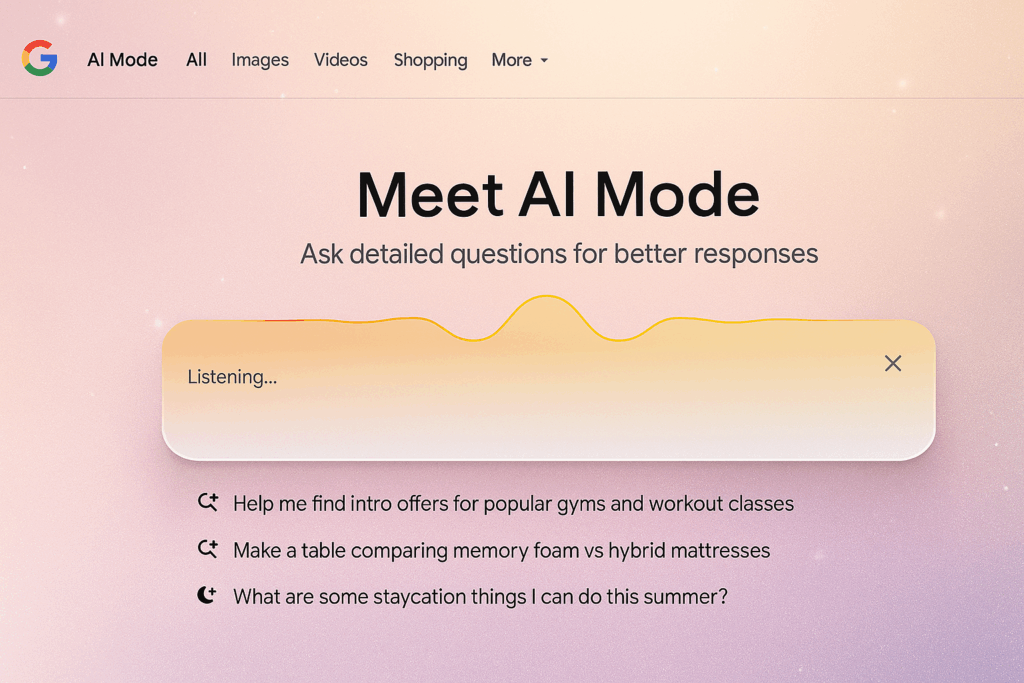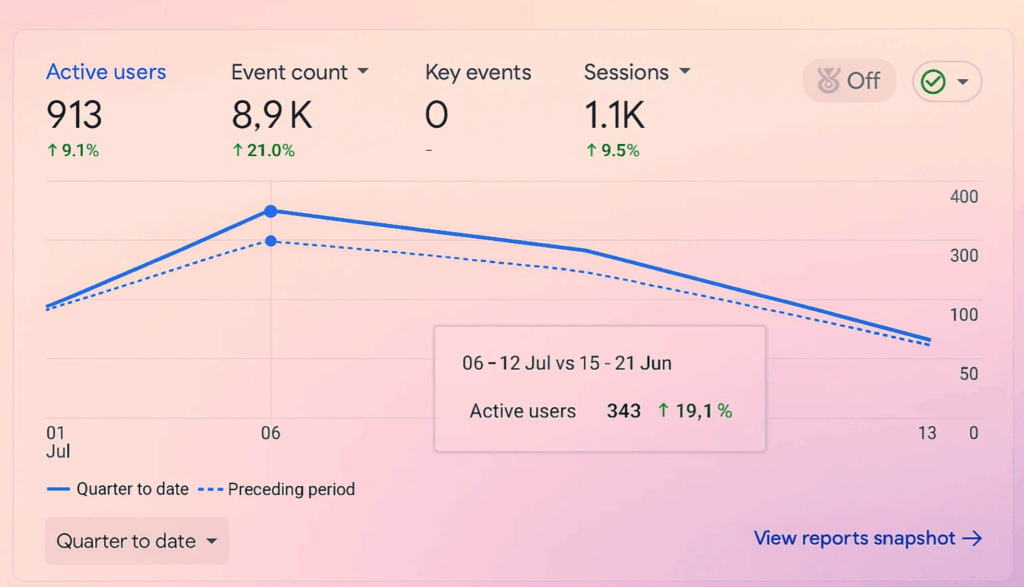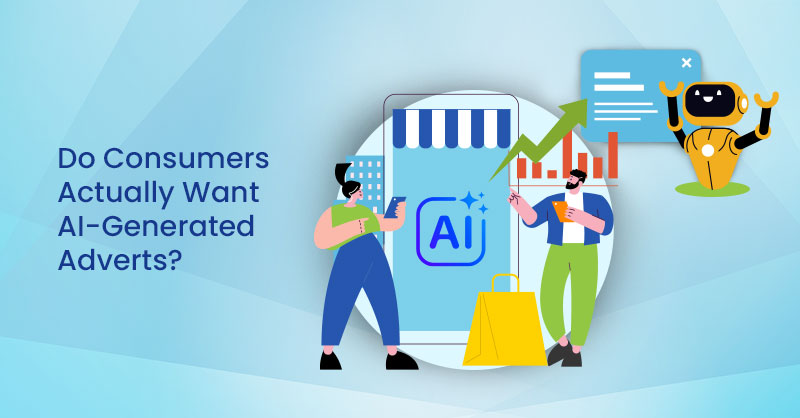What is Google’s AI Mode?

Source: SORA
Google’s AI Mode is changing the way we search. It’s not just another flashy tool or feature from Google, but it’s an evolution of how search engines work. Instead of simply returning a list of links for you to explore, AI Mode offers direct answers to your questions right in the search results.
What’s happening here is that Google’s generative AI pulls information from a wide range of sources across the web, then combines and presents it in a way that’s clear, concise, and directly relevant to your query. Gone are the days when you had to click through several sites to find what you were looking for. Now, you get immediate responses, often in the form of a well-organized summary, a step-by-step guide, or even product recommendations, right at the top of the page.
What really sets AI Mode apart is its conversational nature. Instead of just getting one static answer, you can ask follow-up questions, and Google’s AI will refine its response, keeping track of the context and adjusting as you go. It’s not just about finding information anymore; it’s about engaging with a tool that responds and adapts to your needs in real-time. AI Mode is doing more than just changing search, but it’s reshaping the entire search experience as well.
A Quick Recap of the Timeline
Before we get into all the juicy details, let’s take a second to go over how we got here. Google I/O 2023 was the starting point. Google announced Search Generative Experience (SGE) as an experimental feature. For the first few months, only a handful of users in the U.S. got access to it through Search Labs.
Fast forward to mid-2023, and Google expanded AI Mode to India and Japan, with support for Hindi and Japanese languages. Then came November 2023, and boom: the feature was live in over 120 countries, adding support for Spanish, Portuguese, Korean, and Indonesian.
By 2025, AI Mode went mainstream. It’s now available in the U.S. and India, and other regions are quickly following. Google has been working its way toward a global rollout, and you’d better believe it’s only going to get bigger from here. We may be seeing this feature in days, weeks or months, but it’s coming, and it’s coming soon.
What Does AI Mode Do?

Source: SORA
Alright, enough about the timeline. Let’s talk about what this actually means for you as a search user (and SEO pro). AI Mode is powered by Google’s generative AI, which doesn’t just show you a list of results anymore. It gives you an actual answer. Here’s how:
AI-Generated Overviews
When you search for something, instead of scrolling through a bunch of links, you might get a detailed AI-generated answer right at the top. For example, if you search "how to cook pasta," you might see a full recipe, step-by-step, without needing to click through to a site. The AI pulls information from various sources and organizes it in a way that’s easy to digest. Plus, it cites its sources, so you can see where the info came from if you want to dive deeper.
Conversational Search
Google’s AI Mode doesn’t just stop at one question and answer. It’s interactive. After getting an initial response, you can ask follow-up questions, and Google remembers what you asked. So if you ask, “What’s the best laptop for gaming?” and then follow up with, “How much should I spend on one?”, the AI will adjust its response accordingly. It’s like having a back-and-forth with Google, getting more personalized answers each time.
Voice and Image Search
You’re not just typing your queries anymore. AI Mode allows you to search by voice or even image. This is huge for mobile users who want to snap a pic of something and ask Google, "What is this?" Whether it’s a plant, a product, or a broken appliance, the AI can interpret the image and provide detailed information.
Rich, Contextual Responses
Depending on what you're searching for, AI Mode adapts its answers. Let’s say you search for a local business. Instead of just showing you a list, you might get a map, reviews, and all the business info right there. Or, if you’re looking for a product, Google might show you a carousel of recommended items with prices. Essentially, it’s about delivering a more comprehensive response that provides what you need without requiring additional clicks.
Real-World Examples: How AI Mode Responds to Service-Based Queries
To really understand how Google’s AI Mode is changing search, let’s look at how it works with local service-based businesses. Instead of just showing a generic list of links, Google’s AI now curates and summarizes the best options, often showing businesses, reviews, and direct answers based on service type, location, and relevance.
Say someone types in: “Best IT support company in Toronto” or “Do I need Managed IT services for a small business?” Rather than just showing a page full of IT company websites, AI Mode may present an overview describing what Managed IT Services include, and list trusted providers in the region, sometimes with contact details, ratings, or even highlighted client reviews. This is a major opportunity for companies like Connectability who specialize in IT Support Services and offer Managed IT Solutions. If their content is well-structured and clearly answers those queries, they can earn citations in these AI-generated summaries, increasing brand visibility without relying on traditional SEO rankings.
Now let’s switch industries. Imagine a winter homeowner searching: “Who clears snow for driveways near me?” or “How to find a licensed demolition contractor?” Google AI Mode may instantly show a brief description of the demolition process or walk you through the costs and permits involved, and then cite trusted providers like MOD Demolition, a reputable Demolition Contractor who also does Snow Removal in Sault Ste. Marie. This level of detail wasn’t available before, and now, smaller service businesses have a shot at appearing directly in front of high-intent users, without needing to rank #1.
The key takeaway? AI Mode levels the playing field. Whether you’re in tech support or construction, your content just needs to be helpful, accurate, and optimized for AI to pick up. That’s where citation-based SEO truly shines.
The SEO Impact: Is This a Good or Bad Thing?
So now that you know what is all AI Mode about, you’re probably wondering: how does this affect SEO?
The short answer: it’s a game-changer. Here’s how:
Click-Through Rates Are Dropping
Since Google’s AI is providing direct answers right in the search results, users don’t need to click on your website to get the info they’re looking for. This means fewer clicks, and in turn, less organic traffic. If you’re used to relying on people clicking through to your site from the search results, this is a big shift. You could see traffic drop for those types of informational queries.
Citations Are the New Backlinks
For years, SEO has been all about backlinks, which are those links from other sites that point to yours. But with AI Mode, citations are becoming just as valuable. Google’s AI pulls information from different sources, and when it cites your content, it gives you visibility, even if the user doesn’t click on your link. This is a big win for brand awareness. If your brand keeps popping up in Google’s AI responses, users will start to recognize you. They may even search for your brand directly later on.
Brand Exposure Without the Click
The best part? Even without the click, your brand gets exposure. Think about it: AI Mode puts your brand front and center in the search results. Even if people don’t click, they’re seeing your name and recognizing it. Over time, this can drive branded searches, where users search for your brand directly, bypassing the AI answers entirely.
Instant Authority
Getting cited by Google’s AI alongside big names in your industry? That’s instant credibility. Even if you’re not ranking #1 for every keyword, being included in an AI-generated answer positions you as a trusted authority. AI Mode is giving smaller brands the chance to be seen alongside the big players, as long as their content is valuable and well-structured.
How to Adapt Your SEO Strategy for AI Mode

Source: SORA
Now that we know how AI Mode is affecting traffic, the big question is: what can we do about it? How do we adjust our SEO strategies for this new world?
Shift Your Focus to Citations
Forget just chasing backlinks. Now it’s all about getting cited in AI answers. How do you do that? It’s simple: create high-quality, easy-to-understand content that directly answers questions. If you want to increase your chances of being cited by AI, make sure your content is well-structured, concise, and clear.
Think Conversational
AI Mode is designed to handle conversational queries, so you need to make sure your content answers those kinds of questions. Instead of focusing on broad keywords like “best camera,” target more long-tail, conversational phrases like “What’s the best camera for travel under $500?” By answering specific questions directly, your content becomes a natural fit for Google’s AI to pull from.
Optimize with Structured Data
To make your content even easier for Google’s AI to use, add structured data to your pages. Schema markup like FAQPage and HowTo schema helps Google understand your content, which increases your chances of being featured in AI Mode. Think of it as giving Google a roadmap for how to pull information from your content.
Keep an Eye on Brand Exposure
Even if you’re not getting clicks, AI Mode is still helping your brand get exposure. If your content is cited often, track your branded search traffic. Are people searching for your brand directly after seeing your name in an AI response? If so, you’re on the right track.
AI Mode in Search
Where does this all go from here? Google isn’t done yet. AI Mode is still evolving, and we’re only seeing the tip of the iceberg. In the next few years, we can expect even more features and wider global adoption.
- More languages: Expect AI Mode to be rolled out in more regions and languages as Google expands.
- Advanced features like Deep Search (helping with more detailed research) and Search Live, where Google can respond in real-time through voice and images.
- Integration across Google products, like Google Assistant and Chrome, making AI-powered search even more embedded into our daily lives.
For SEO pros and businesses, it’s all about adapting to this change. Focus on creating high-quality, valuable content and making sure it’s easily discoverable by Google’s AI. If you do that, you’ll keep your brand in the spotlight—AI-driven spotlight, that is.
Adapting Your SEO Strategy for the AI-Powered Future of Search
AI Mode is here to stay, and it’s changing everything about how we search. While traditional SEO might seem like it’s on its way out, it’s really just evolving. The future is all about getting cited by Google’s AI, staying visible without the clicks, and adapting your content to fit a more conversational, user-friendly model.
If you’re not adjusting your strategy for AI Mode now, you might find yourself left behind. It’s not just about ranking anymore; it’s about getting in the conversation.
So, what’s your next step? Make sure your content is optimized for AI citations, answer those conversational queries, and watch your brand thrive in this new world of search.
Top 12 Questions About Google AI Mode and How It Affects Your SEO
How does Google’s AI Mode impact my Google Business Profile?
In AI Mode, Google pulls data directly from sources like your Google Business Profile to generate instant answers. To stay visible, make sure your profile is fully optimized by including up-to-date hours, address, phone number, website, service details, and photos. AI Overviews prioritize businesses with complete, verified, and well-managed profiles, especially for local queries.
Will customer reviews still matter in an AI-driven search experience?
Absolutely. AI Overviews consider sentiment and review volume when selecting sources to feature. Encouraging consistent, high-quality reviews, and responding to them, signals trust and authority. In AI Mode, businesses with more recent, positive feedback are more likely to be referenced in summaries or local packs.
Do keywords still matter when AI is writing the answers?
Yes, and possibly even more. AI Mode still relies on structured content and keyword relevance to determine what answers to serve. Integrate natural language keywords into your site, headings, and metadata. Think about how real people ask questions, since AI uses those questions to generate overviews.
How does a mobile-friendly website help me show up in AI Mode?
AI Mode favours user-friendly, fast, and accessible websites, especially on mobile. A responsive design isn’t just good UX; it’s an SEO signal. If AI pulls content from your site, Google will prefer sources that are fast-loading and easy to navigate, especially on mobile.
Is content still king in a world where Google writes the answers?
Yes, but it needs to be smarter, more helpful, and more structured. Google’s AI Overviews pull from sites that clearly answer specific user questions. Invest in well-written, original content, like how-to guides, FAQs, and topical blogs that match user intent. AI can’t replace your expertise, but it can amplify it if your content is useful.
Should I still run Google Ads if organic visibility is being replaced by AI answers?
More than ever. AI Mode reduces clicks on organic links, especially when answers are displayed inline. Running Google Ads ensures your business still shows up prominently, especially for transactional or high-intent queries. It’s a hedge against lost organic impressions.
What role does Google Analytics play in an AI-dominated landscape?
Use Google Analytics to monitor how AI Mode is affecting your traffic. Look for drops in organic sessions, shifts in referral sources, or changes in behaviour. This data helps you identify if your content is still surfacing or if you need to adjust strategies for visibility in zero-click environments.
Why should I use Google Search Console now more than ever?
Search Console is your direct line to how Google sees your site. With AI Mode changing how content is served, you need to monitor impressions, clicks, crawl errors, and indexing. Submitting clean sitemaps and fixing issues helps Google’s AI index your content correctly and consider it for Overviews.
Does site speed affect how AI pulls my content?
Yes. Slow sites are less likely to be crawled or used in AI Overviews. Google wants reliable, fast-loading pages for AI-sourced content. Optimize your images, compress files, and use a strong host, especially since users clicking through from AI results expect speed.
How do I adapt my SEO strategy for local visibility in AI Mode?
AI Mode is heavily geared toward local intent. To rank locally, use location-specific keywords, maintain consistent NAP (name, address, phone number) data, and build location-focused pages. AI often pulls from the best local matching sources, so make sure your information is structured and relevant.
Do backlinks still matter in the age of AI-generated answers?
Yes, but quality over quantity is key. AI Mode favours authoritative sources, so backlinks from trusted, reputable sites help you get featured. Focus on industry publications, local news, and partners; the types of domains Google’s AI is more likely to trust when building answers.
How do I keep up with Google’s AI changes and stay competitive?
Stay plugged into SEO news, Google's official updates, and track how your content is performing. AI Mode is evolving rapidly, so what works today may change tomorrow. Test formats, refine your content for clarity, and focus on helpful, accurate, and structured answers if you want your site to appear in AI-driven search.
For the latest digital marketing updates, check out our blog. To book an appointment, call
866-208-3095 or contact us here.





